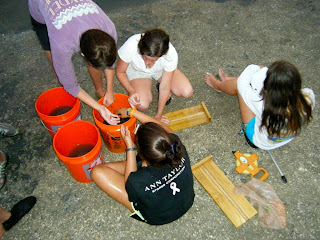 |
| The Last Day of Class |
This course definitely helped prepare for the real world of marine science by immersing us in activities that many people will never get the chance to do or see, especially as undergrads. How many other people will get the chance to go on a research vessel in their lifetime, let alone as a student? When do people get the chance to take a sediment core sample and determine the history of that location simply by performing a few tests and analyzing the composition? How many people do you know that get the chance to see some of the most beautiful reefs in the United States and how they are actively being restored? How many chances will you get to spend 24 hours in an ecosystem and see for yourself the changes that can occur? All these things were possible for me to do, but only because I took this course. If I had not, the places would still be there but I would not have the equipment or instruction to perform these activities alone.
Though I took this class hoping that it would point me in the direction of what I wanted to pursue as a career, it instead opened many more doors. There are so many things that can be done in the Marine Science, as it is a truly diverse field.
Finally I'd like to thank all the professors who took part in creating this unique course, as well as our graduate T.A. Breanna Korsman for putting up with us and being our only liaison from site to site.
 |
| Learning about the Fossil Reefs of Windley Key |
 |
| Counting and Measuring the species collected in a seine net during our 24 hour Study |
 |
| Coquina Rock Formations of Marineland |
 |
| The Genetic Drift |
 |
| Canoeing to our site while at FGCU |
 |
| Analyzing what was found at Ft. De Soto |
 |
| Learning about Coral Restoration at Mote Marine Lab |
 |
| The Weatherbird during T.S. Andrea |
 |
| Analyzing Algae Samples at Keys Marine Lab |
 |
| Recording Water Quality Parameters during our 24 hour Study |
 |
| Finding things in the Sargassum at Bahia Honda State Park |
 |
| Homework Time at FGCU |
 |
| Sediment Core from FGCU |
 |
| Dr. Hackney watching the sunset during our 24 hour study |
 |
| Analyzing Sea Grass off the coast of Koch Key |
 |
| Oyster Reefs near Vester Marine Lab |
No comments:
Post a Comment